Bachelor Nursing Assignment: Palliative Care for Lung Cancer Patient
VerifiedAdded on 2022/11/24
|10
|3121
|404
Essay
AI Summary
This nursing assignment examines a case study of a 55-year-old Aboriginal man, Tom, suffering from advanced lung cancer with metastases, admitted to the hospital with severe breathlessness and pain. The essay focuses on the application of palliative care principles, addressing pain management, including assessment, interventions, and evaluation, with consideration for cultural sensitivities. It also delves into the identification, assessment, and management of breathlessness, exploring various interventions such as oxygen therapy and medication. The assignment emphasizes the crucial role of nurses in providing comfort, emotional support, and effective communication, particularly highlighting the importance of family involvement and the need for palliative care at the end-of-life stage. The essay incorporates evidence-based rationales for interventions, monitoring, and evaluation strategies, with references to relevant literature and guidelines.
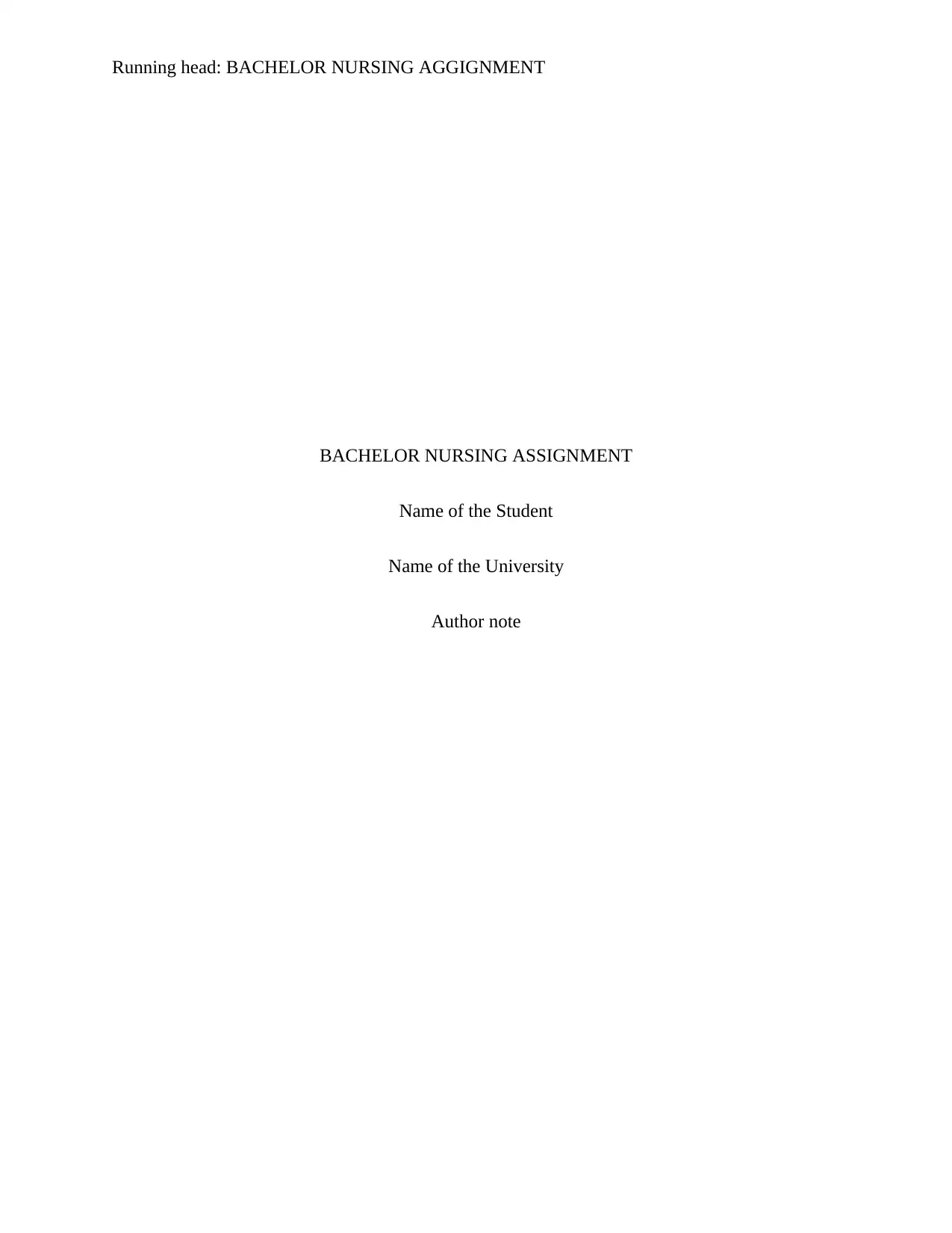
Running head: BACHELOR NURSING AGGIGNMENT
BACHELOR NURSING ASSIGNMENT
Name of the Student
Name of the University
Author note
BACHELOR NURSING ASSIGNMENT
Name of the Student
Name of the University
Author note
Paraphrase This Document
Need a fresh take? Get an instant paraphrase of this document with our AI Paraphraser
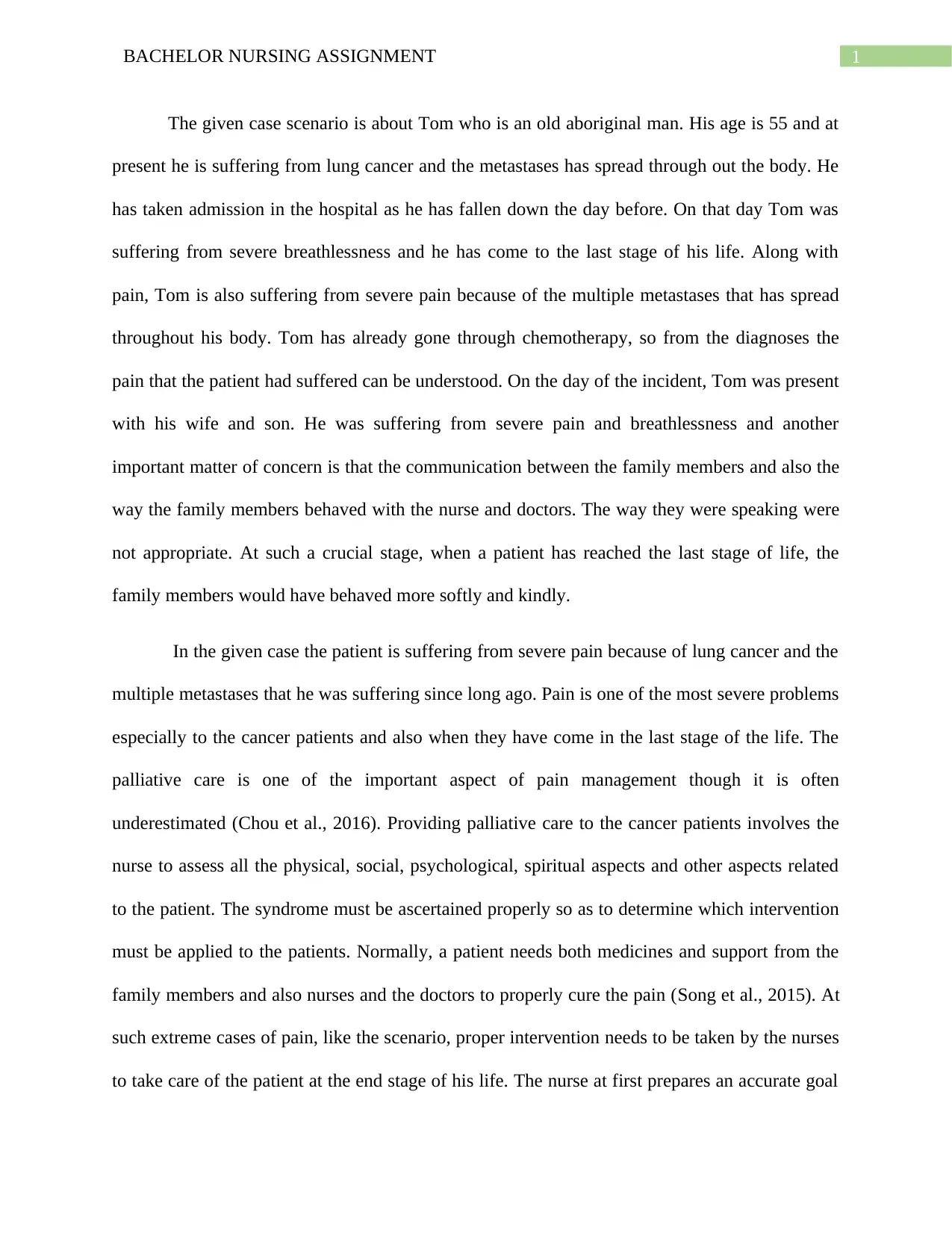
1BACHELOR NURSING ASSIGNMENT
The given case scenario is about Tom who is an old aboriginal man. His age is 55 and at
present he is suffering from lung cancer and the metastases has spread through out the body. He
has taken admission in the hospital as he has fallen down the day before. On that day Tom was
suffering from severe breathlessness and he has come to the last stage of his life. Along with
pain, Tom is also suffering from severe pain because of the multiple metastases that has spread
throughout his body. Tom has already gone through chemotherapy, so from the diagnoses the
pain that the patient had suffered can be understood. On the day of the incident, Tom was present
with his wife and son. He was suffering from severe pain and breathlessness and another
important matter of concern is that the communication between the family members and also the
way the family members behaved with the nurse and doctors. The way they were speaking were
not appropriate. At such a crucial stage, when a patient has reached the last stage of life, the
family members would have behaved more softly and kindly.
In the given case the patient is suffering from severe pain because of lung cancer and the
multiple metastases that he was suffering since long ago. Pain is one of the most severe problems
especially to the cancer patients and also when they have come in the last stage of the life. The
palliative care is one of the important aspect of pain management though it is often
underestimated (Chou et al., 2016). Providing palliative care to the cancer patients involves the
nurse to assess all the physical, social, psychological, spiritual aspects and other aspects related
to the patient. The syndrome must be ascertained properly so as to determine which intervention
must be applied to the patients. Normally, a patient needs both medicines and support from the
family members and also nurses and the doctors to properly cure the pain (Song et al., 2015). At
such extreme cases of pain, like the scenario, proper intervention needs to be taken by the nurses
to take care of the patient at the end stage of his life. The nurse at first prepares an accurate goal
The given case scenario is about Tom who is an old aboriginal man. His age is 55 and at
present he is suffering from lung cancer and the metastases has spread through out the body. He
has taken admission in the hospital as he has fallen down the day before. On that day Tom was
suffering from severe breathlessness and he has come to the last stage of his life. Along with
pain, Tom is also suffering from severe pain because of the multiple metastases that has spread
throughout his body. Tom has already gone through chemotherapy, so from the diagnoses the
pain that the patient had suffered can be understood. On the day of the incident, Tom was present
with his wife and son. He was suffering from severe pain and breathlessness and another
important matter of concern is that the communication between the family members and also the
way the family members behaved with the nurse and doctors. The way they were speaking were
not appropriate. At such a crucial stage, when a patient has reached the last stage of life, the
family members would have behaved more softly and kindly.
In the given case the patient is suffering from severe pain because of lung cancer and the
multiple metastases that he was suffering since long ago. Pain is one of the most severe problems
especially to the cancer patients and also when they have come in the last stage of the life. The
palliative care is one of the important aspect of pain management though it is often
underestimated (Chou et al., 2016). Providing palliative care to the cancer patients involves the
nurse to assess all the physical, social, psychological, spiritual aspects and other aspects related
to the patient. The syndrome must be ascertained properly so as to determine which intervention
must be applied to the patients. Normally, a patient needs both medicines and support from the
family members and also nurses and the doctors to properly cure the pain (Song et al., 2015). At
such extreme cases of pain, like the scenario, proper intervention needs to be taken by the nurses
to take care of the patient at the end stage of his life. The nurse at first prepares an accurate goal
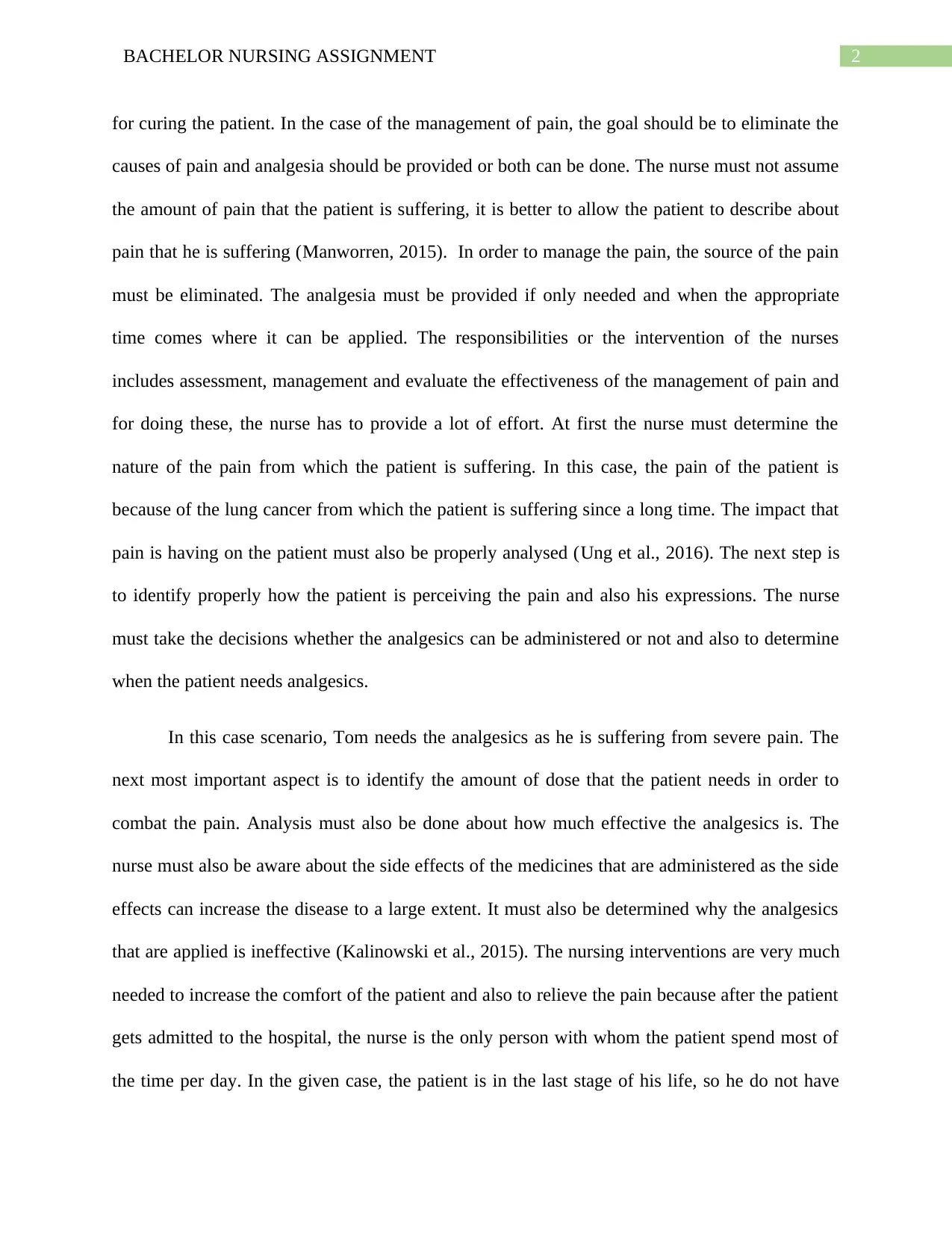
2BACHELOR NURSING ASSIGNMENT
for curing the patient. In the case of the management of pain, the goal should be to eliminate the
causes of pain and analgesia should be provided or both can be done. The nurse must not assume
the amount of pain that the patient is suffering, it is better to allow the patient to describe about
pain that he is suffering (Manworren, 2015). In order to manage the pain, the source of the pain
must be eliminated. The analgesia must be provided if only needed and when the appropriate
time comes where it can be applied. The responsibilities or the intervention of the nurses
includes assessment, management and evaluate the effectiveness of the management of pain and
for doing these, the nurse has to provide a lot of effort. At first the nurse must determine the
nature of the pain from which the patient is suffering. In this case, the pain of the patient is
because of the lung cancer from which the patient is suffering since a long time. The impact that
pain is having on the patient must also be properly analysed (Ung et al., 2016). The next step is
to identify properly how the patient is perceiving the pain and also his expressions. The nurse
must take the decisions whether the analgesics can be administered or not and also to determine
when the patient needs analgesics.
In this case scenario, Tom needs the analgesics as he is suffering from severe pain. The
next most important aspect is to identify the amount of dose that the patient needs in order to
combat the pain. Analysis must also be done about how much effective the analgesics is. The
nurse must also be aware about the side effects of the medicines that are administered as the side
effects can increase the disease to a large extent. It must also be determined why the analgesics
that are applied is ineffective (Kalinowski et al., 2015). The nursing interventions are very much
needed to increase the comfort of the patient and also to relieve the pain because after the patient
gets admitted to the hospital, the nurse is the only person with whom the patient spend most of
the time per day. In the given case, the patient is in the last stage of his life, so he do not have
for curing the patient. In the case of the management of pain, the goal should be to eliminate the
causes of pain and analgesia should be provided or both can be done. The nurse must not assume
the amount of pain that the patient is suffering, it is better to allow the patient to describe about
pain that he is suffering (Manworren, 2015). In order to manage the pain, the source of the pain
must be eliminated. The analgesia must be provided if only needed and when the appropriate
time comes where it can be applied. The responsibilities or the intervention of the nurses
includes assessment, management and evaluate the effectiveness of the management of pain and
for doing these, the nurse has to provide a lot of effort. At first the nurse must determine the
nature of the pain from which the patient is suffering. In this case, the pain of the patient is
because of the lung cancer from which the patient is suffering since a long time. The impact that
pain is having on the patient must also be properly analysed (Ung et al., 2016). The next step is
to identify properly how the patient is perceiving the pain and also his expressions. The nurse
must take the decisions whether the analgesics can be administered or not and also to determine
when the patient needs analgesics.
In this case scenario, Tom needs the analgesics as he is suffering from severe pain. The
next most important aspect is to identify the amount of dose that the patient needs in order to
combat the pain. Analysis must also be done about how much effective the analgesics is. The
nurse must also be aware about the side effects of the medicines that are administered as the side
effects can increase the disease to a large extent. It must also be determined why the analgesics
that are applied is ineffective (Kalinowski et al., 2015). The nursing interventions are very much
needed to increase the comfort of the patient and also to relieve the pain because after the patient
gets admitted to the hospital, the nurse is the only person with whom the patient spend most of
the time per day. In the given case, the patient is in the last stage of his life, so he do not have
⊘ This is a preview!⊘
Do you want full access?
Subscribe today to unlock all pages.

Trusted by 1+ million students worldwide
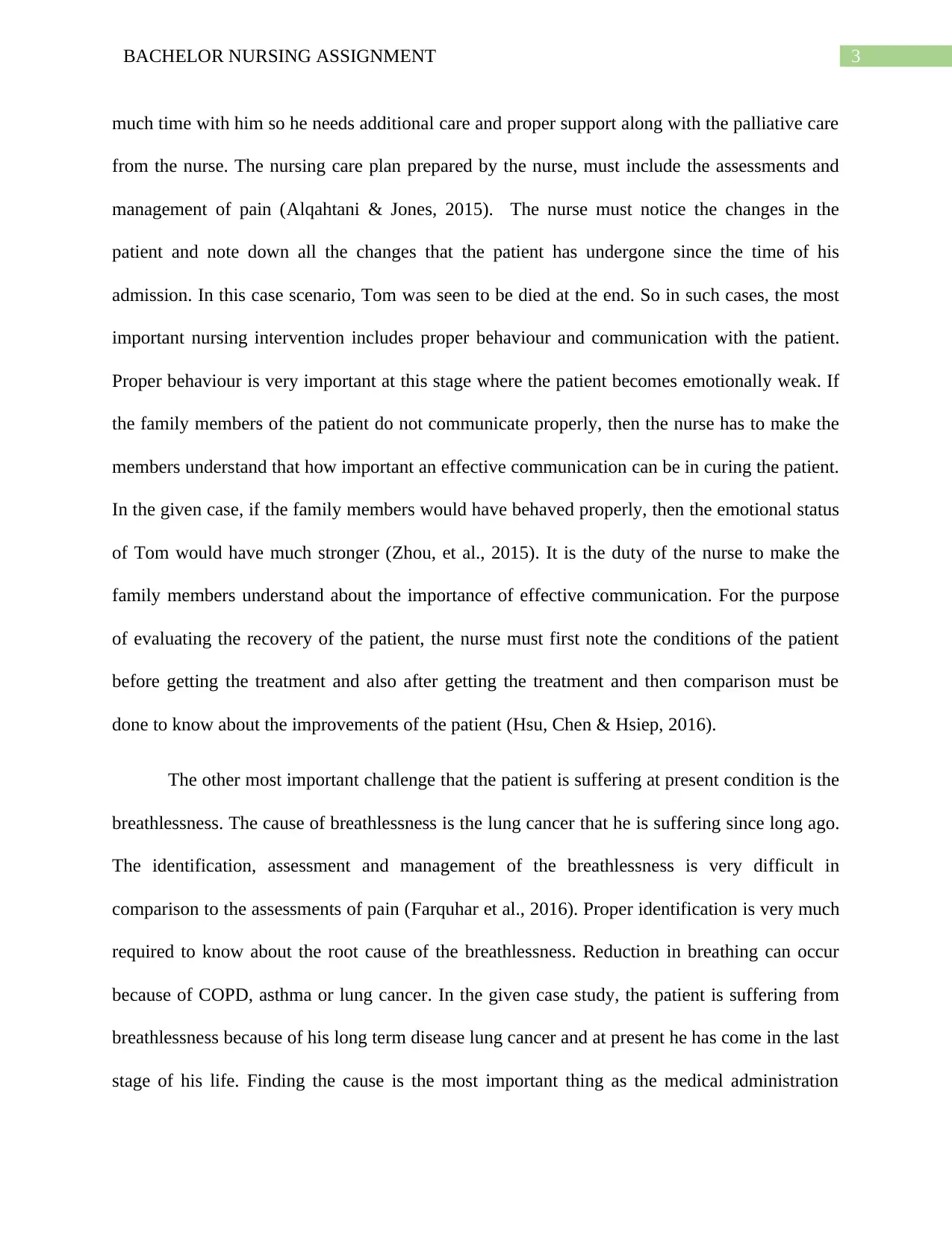
3BACHELOR NURSING ASSIGNMENT
much time with him so he needs additional care and proper support along with the palliative care
from the nurse. The nursing care plan prepared by the nurse, must include the assessments and
management of pain (Alqahtani & Jones, 2015). The nurse must notice the changes in the
patient and note down all the changes that the patient has undergone since the time of his
admission. In this case scenario, Tom was seen to be died at the end. So in such cases, the most
important nursing intervention includes proper behaviour and communication with the patient.
Proper behaviour is very important at this stage where the patient becomes emotionally weak. If
the family members of the patient do not communicate properly, then the nurse has to make the
members understand that how important an effective communication can be in curing the patient.
In the given case, if the family members would have behaved properly, then the emotional status
of Tom would have much stronger (Zhou, et al., 2015). It is the duty of the nurse to make the
family members understand about the importance of effective communication. For the purpose
of evaluating the recovery of the patient, the nurse must first note the conditions of the patient
before getting the treatment and also after getting the treatment and then comparison must be
done to know about the improvements of the patient (Hsu, Chen & Hsiep, 2016).
The other most important challenge that the patient is suffering at present condition is the
breathlessness. The cause of breathlessness is the lung cancer that he is suffering since long ago.
The identification, assessment and management of the breathlessness is very difficult in
comparison to the assessments of pain (Farquhar et al., 2016). Proper identification is very much
required to know about the root cause of the breathlessness. Reduction in breathing can occur
because of COPD, asthma or lung cancer. In the given case study, the patient is suffering from
breathlessness because of his long term disease lung cancer and at present he has come in the last
stage of his life. Finding the cause is the most important thing as the medical administration
much time with him so he needs additional care and proper support along with the palliative care
from the nurse. The nursing care plan prepared by the nurse, must include the assessments and
management of pain (Alqahtani & Jones, 2015). The nurse must notice the changes in the
patient and note down all the changes that the patient has undergone since the time of his
admission. In this case scenario, Tom was seen to be died at the end. So in such cases, the most
important nursing intervention includes proper behaviour and communication with the patient.
Proper behaviour is very important at this stage where the patient becomes emotionally weak. If
the family members of the patient do not communicate properly, then the nurse has to make the
members understand that how important an effective communication can be in curing the patient.
In the given case, if the family members would have behaved properly, then the emotional status
of Tom would have much stronger (Zhou, et al., 2015). It is the duty of the nurse to make the
family members understand about the importance of effective communication. For the purpose
of evaluating the recovery of the patient, the nurse must first note the conditions of the patient
before getting the treatment and also after getting the treatment and then comparison must be
done to know about the improvements of the patient (Hsu, Chen & Hsiep, 2016).
The other most important challenge that the patient is suffering at present condition is the
breathlessness. The cause of breathlessness is the lung cancer that he is suffering since long ago.
The identification, assessment and management of the breathlessness is very difficult in
comparison to the assessments of pain (Farquhar et al., 2016). Proper identification is very much
required to know about the root cause of the breathlessness. Reduction in breathing can occur
because of COPD, asthma or lung cancer. In the given case study, the patient is suffering from
breathlessness because of his long term disease lung cancer and at present he has come in the last
stage of his life. Finding the cause is the most important thing as the medical administration
Paraphrase This Document
Need a fresh take? Get an instant paraphrase of this document with our AI Paraphraser
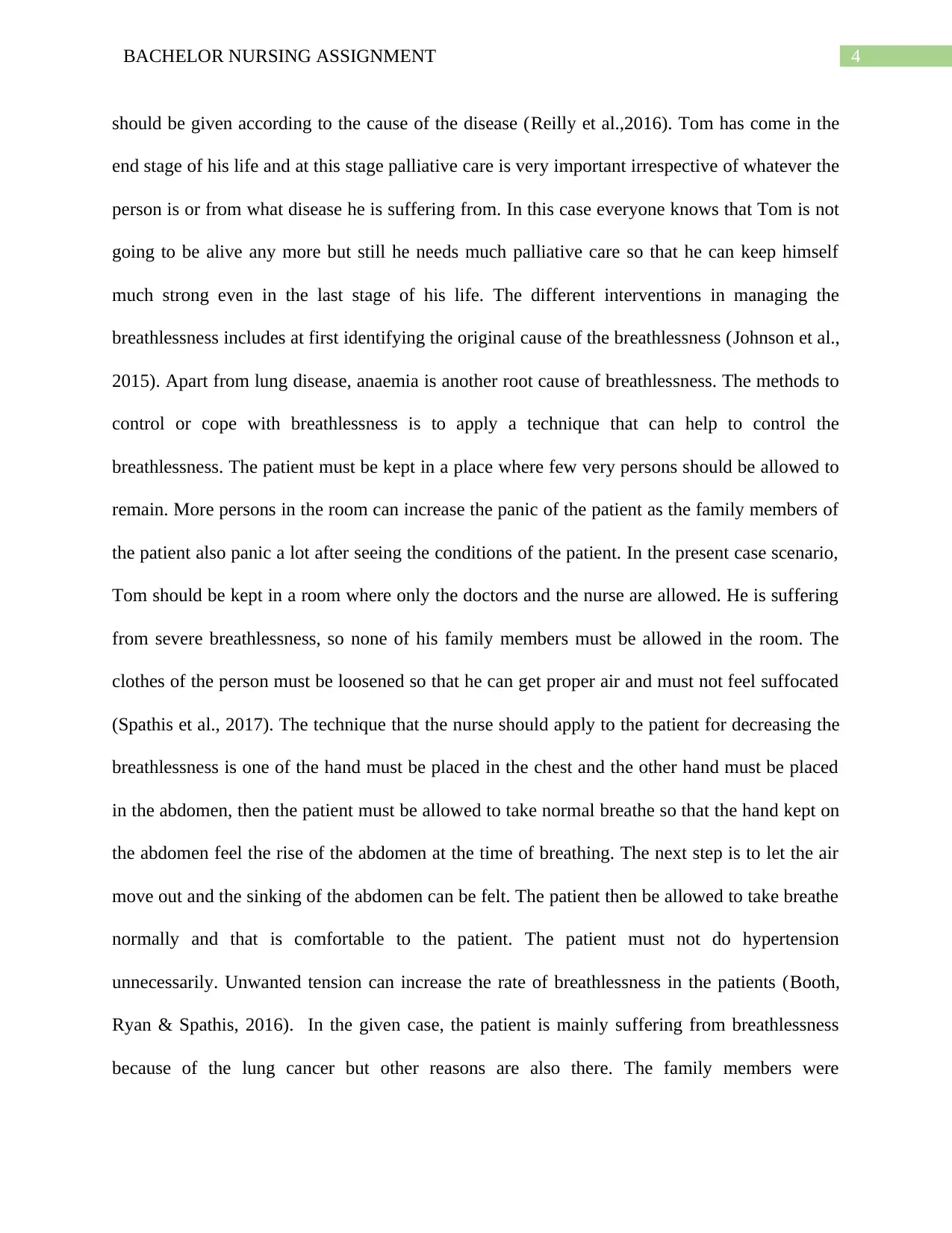
4BACHELOR NURSING ASSIGNMENT
should be given according to the cause of the disease (Reilly et al.,2016). Tom has come in the
end stage of his life and at this stage palliative care is very important irrespective of whatever the
person is or from what disease he is suffering from. In this case everyone knows that Tom is not
going to be alive any more but still he needs much palliative care so that he can keep himself
much strong even in the last stage of his life. The different interventions in managing the
breathlessness includes at first identifying the original cause of the breathlessness (Johnson et al.,
2015). Apart from lung disease, anaemia is another root cause of breathlessness. The methods to
control or cope with breathlessness is to apply a technique that can help to control the
breathlessness. The patient must be kept in a place where few very persons should be allowed to
remain. More persons in the room can increase the panic of the patient as the family members of
the patient also panic a lot after seeing the conditions of the patient. In the present case scenario,
Tom should be kept in a room where only the doctors and the nurse are allowed. He is suffering
from severe breathlessness, so none of his family members must be allowed in the room. The
clothes of the person must be loosened so that he can get proper air and must not feel suffocated
(Spathis et al., 2017). The technique that the nurse should apply to the patient for decreasing the
breathlessness is one of the hand must be placed in the chest and the other hand must be placed
in the abdomen, then the patient must be allowed to take normal breathe so that the hand kept on
the abdomen feel the rise of the abdomen at the time of breathing. The next step is to let the air
move out and the sinking of the abdomen can be felt. The patient then be allowed to take breathe
normally and that is comfortable to the patient. The patient must not do hypertension
unnecessarily. Unwanted tension can increase the rate of breathlessness in the patients (Booth,
Ryan & Spathis, 2016). In the given case, the patient is mainly suffering from breathlessness
because of the lung cancer but other reasons are also there. The family members were
should be given according to the cause of the disease (Reilly et al.,2016). Tom has come in the
end stage of his life and at this stage palliative care is very important irrespective of whatever the
person is or from what disease he is suffering from. In this case everyone knows that Tom is not
going to be alive any more but still he needs much palliative care so that he can keep himself
much strong even in the last stage of his life. The different interventions in managing the
breathlessness includes at first identifying the original cause of the breathlessness (Johnson et al.,
2015). Apart from lung disease, anaemia is another root cause of breathlessness. The methods to
control or cope with breathlessness is to apply a technique that can help to control the
breathlessness. The patient must be kept in a place where few very persons should be allowed to
remain. More persons in the room can increase the panic of the patient as the family members of
the patient also panic a lot after seeing the conditions of the patient. In the present case scenario,
Tom should be kept in a room where only the doctors and the nurse are allowed. He is suffering
from severe breathlessness, so none of his family members must be allowed in the room. The
clothes of the person must be loosened so that he can get proper air and must not feel suffocated
(Spathis et al., 2017). The technique that the nurse should apply to the patient for decreasing the
breathlessness is one of the hand must be placed in the chest and the other hand must be placed
in the abdomen, then the patient must be allowed to take normal breathe so that the hand kept on
the abdomen feel the rise of the abdomen at the time of breathing. The next step is to let the air
move out and the sinking of the abdomen can be felt. The patient then be allowed to take breathe
normally and that is comfortable to the patient. The patient must not do hypertension
unnecessarily. Unwanted tension can increase the rate of breathlessness in the patients (Booth,
Ryan & Spathis, 2016). In the given case, the patient is mainly suffering from breathlessness
because of the lung cancer but other reasons are also there. The family members were
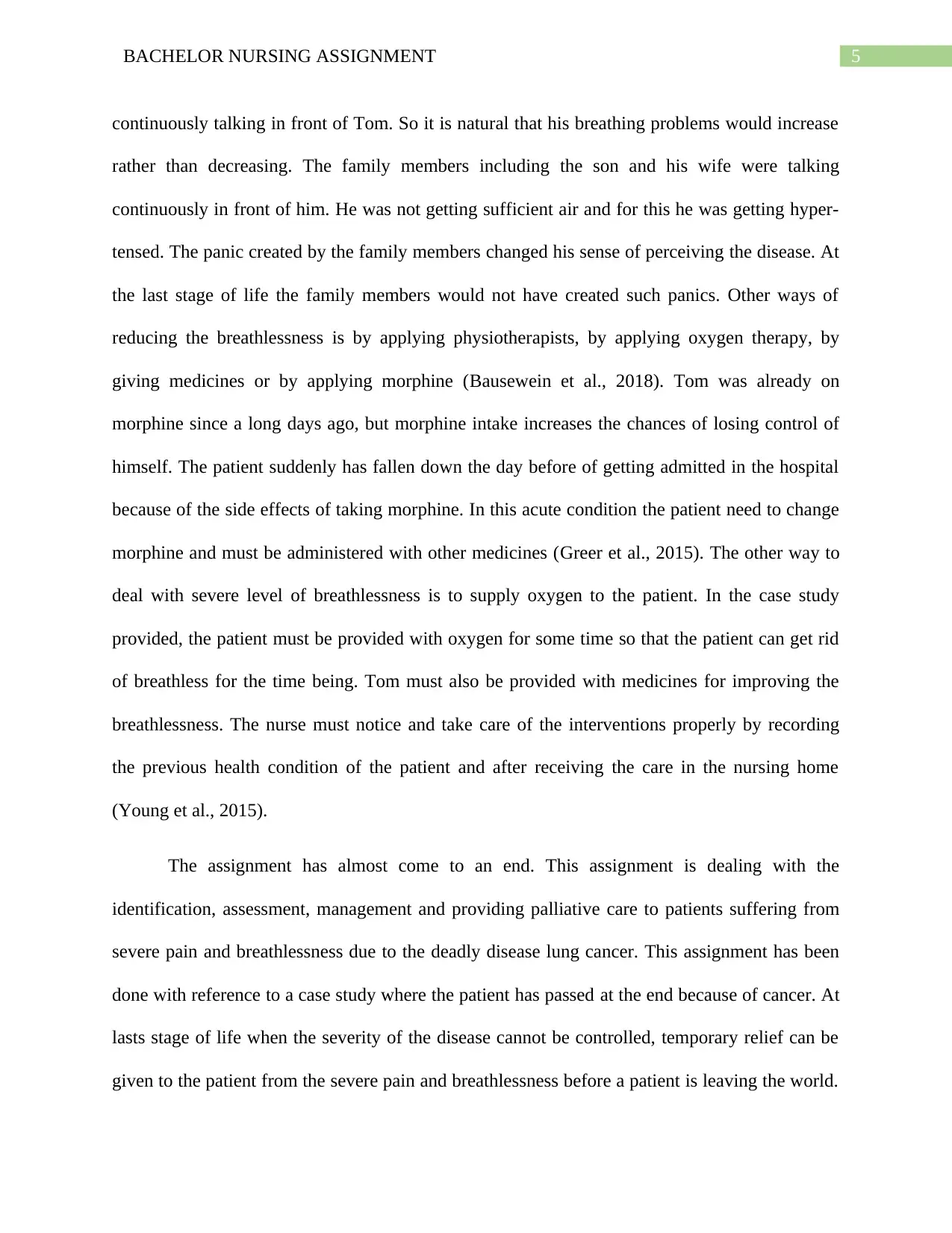
5BACHELOR NURSING ASSIGNMENT
continuously talking in front of Tom. So it is natural that his breathing problems would increase
rather than decreasing. The family members including the son and his wife were talking
continuously in front of him. He was not getting sufficient air and for this he was getting hyper-
tensed. The panic created by the family members changed his sense of perceiving the disease. At
the last stage of life the family members would not have created such panics. Other ways of
reducing the breathlessness is by applying physiotherapists, by applying oxygen therapy, by
giving medicines or by applying morphine (Bausewein et al., 2018). Tom was already on
morphine since a long days ago, but morphine intake increases the chances of losing control of
himself. The patient suddenly has fallen down the day before of getting admitted in the hospital
because of the side effects of taking morphine. In this acute condition the patient need to change
morphine and must be administered with other medicines (Greer et al., 2015). The other way to
deal with severe level of breathlessness is to supply oxygen to the patient. In the case study
provided, the patient must be provided with oxygen for some time so that the patient can get rid
of breathless for the time being. Tom must also be provided with medicines for improving the
breathlessness. The nurse must notice and take care of the interventions properly by recording
the previous health condition of the patient and after receiving the care in the nursing home
(Young et al., 2015).
The assignment has almost come to an end. This assignment is dealing with the
identification, assessment, management and providing palliative care to patients suffering from
severe pain and breathlessness due to the deadly disease lung cancer. This assignment has been
done with reference to a case study where the patient has passed at the end because of cancer. At
lasts stage of life when the severity of the disease cannot be controlled, temporary relief can be
given to the patient from the severe pain and breathlessness before a patient is leaving the world.
continuously talking in front of Tom. So it is natural that his breathing problems would increase
rather than decreasing. The family members including the son and his wife were talking
continuously in front of him. He was not getting sufficient air and for this he was getting hyper-
tensed. The panic created by the family members changed his sense of perceiving the disease. At
the last stage of life the family members would not have created such panics. Other ways of
reducing the breathlessness is by applying physiotherapists, by applying oxygen therapy, by
giving medicines or by applying morphine (Bausewein et al., 2018). Tom was already on
morphine since a long days ago, but morphine intake increases the chances of losing control of
himself. The patient suddenly has fallen down the day before of getting admitted in the hospital
because of the side effects of taking morphine. In this acute condition the patient need to change
morphine and must be administered with other medicines (Greer et al., 2015). The other way to
deal with severe level of breathlessness is to supply oxygen to the patient. In the case study
provided, the patient must be provided with oxygen for some time so that the patient can get rid
of breathless for the time being. Tom must also be provided with medicines for improving the
breathlessness. The nurse must notice and take care of the interventions properly by recording
the previous health condition of the patient and after receiving the care in the nursing home
(Young et al., 2015).
The assignment has almost come to an end. This assignment is dealing with the
identification, assessment, management and providing palliative care to patients suffering from
severe pain and breathlessness due to the deadly disease lung cancer. This assignment has been
done with reference to a case study where the patient has passed at the end because of cancer. At
lasts stage of life when the severity of the disease cannot be controlled, temporary relief can be
given to the patient from the severe pain and breathlessness before a patient is leaving the world.
⊘ This is a preview!⊘
Do you want full access?
Subscribe today to unlock all pages.

Trusted by 1+ million students worldwide
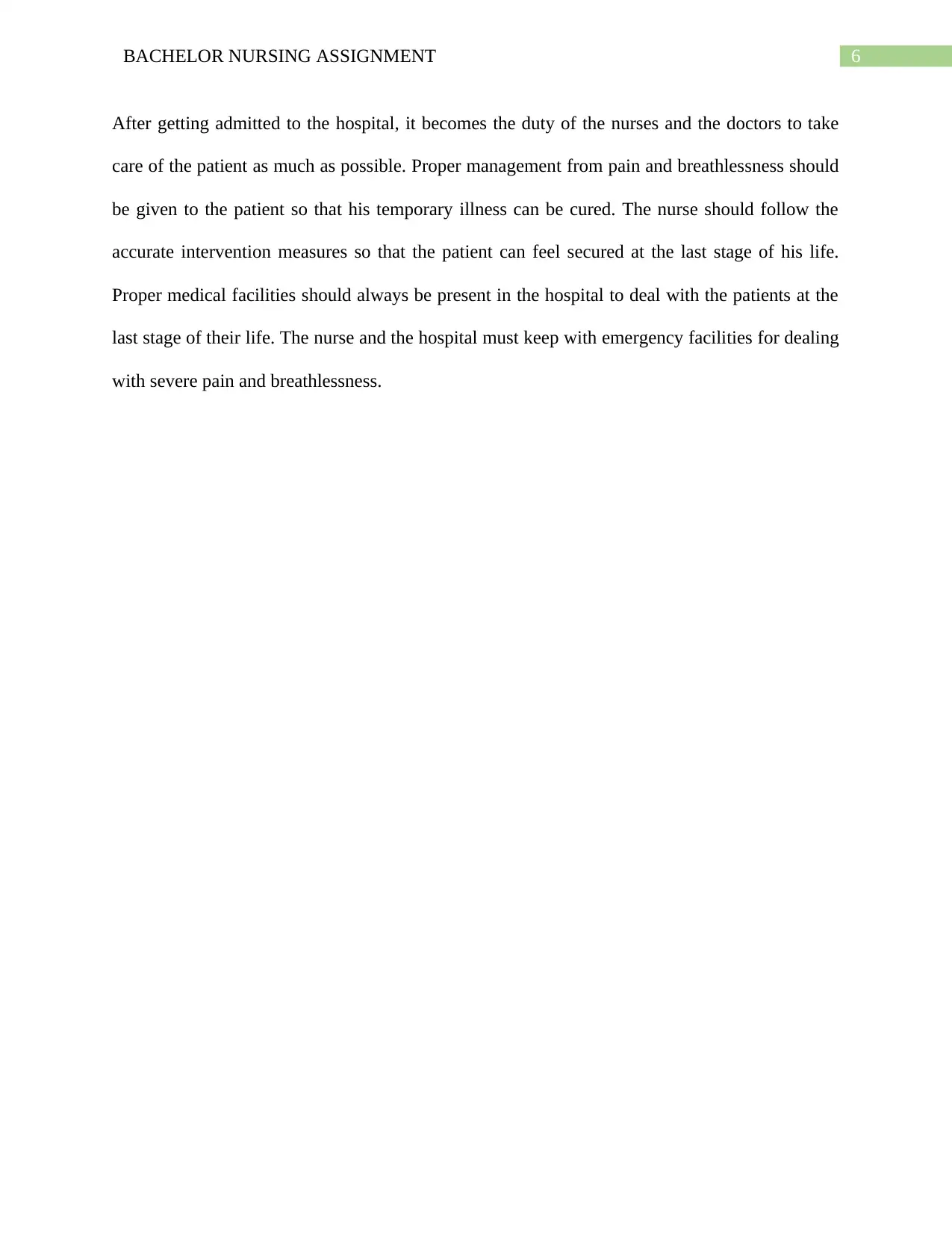
6BACHELOR NURSING ASSIGNMENT
After getting admitted to the hospital, it becomes the duty of the nurses and the doctors to take
care of the patient as much as possible. Proper management from pain and breathlessness should
be given to the patient so that his temporary illness can be cured. The nurse should follow the
accurate intervention measures so that the patient can feel secured at the last stage of his life.
Proper medical facilities should always be present in the hospital to deal with the patients at the
last stage of their life. The nurse and the hospital must keep with emergency facilities for dealing
with severe pain and breathlessness.
After getting admitted to the hospital, it becomes the duty of the nurses and the doctors to take
care of the patient as much as possible. Proper management from pain and breathlessness should
be given to the patient so that his temporary illness can be cured. The nurse should follow the
accurate intervention measures so that the patient can feel secured at the last stage of his life.
Proper medical facilities should always be present in the hospital to deal with the patients at the
last stage of their life. The nurse and the hospital must keep with emergency facilities for dealing
with severe pain and breathlessness.
Paraphrase This Document
Need a fresh take? Get an instant paraphrase of this document with our AI Paraphraser
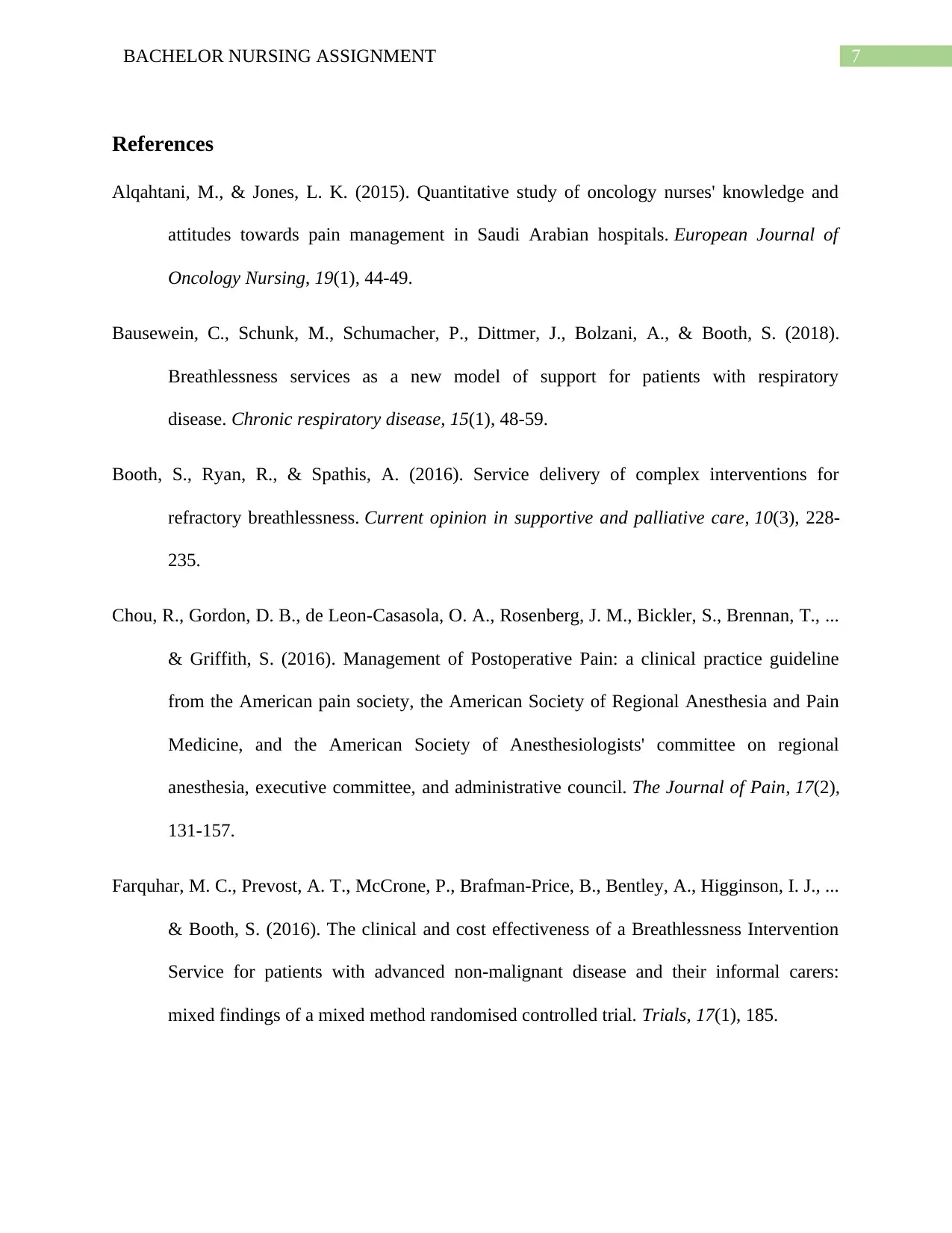
7BACHELOR NURSING ASSIGNMENT
References
Alqahtani, M., & Jones, L. K. (2015). Quantitative study of oncology nurses' knowledge and
attitudes towards pain management in Saudi Arabian hospitals. European Journal of
Oncology Nursing, 19(1), 44-49.
Bausewein, C., Schunk, M., Schumacher, P., Dittmer, J., Bolzani, A., & Booth, S. (2018).
Breathlessness services as a new model of support for patients with respiratory
disease. Chronic respiratory disease, 15(1), 48-59.
Booth, S., Ryan, R., & Spathis, A. (2016). Service delivery of complex interventions for
refractory breathlessness. Current opinion in supportive and palliative care, 10(3), 228-
235.
Chou, R., Gordon, D. B., de Leon-Casasola, O. A., Rosenberg, J. M., Bickler, S., Brennan, T., ...
& Griffith, S. (2016). Management of Postoperative Pain: a clinical practice guideline
from the American pain society, the American Society of Regional Anesthesia and Pain
Medicine, and the American Society of Anesthesiologists' committee on regional
anesthesia, executive committee, and administrative council. The Journal of Pain, 17(2),
131-157.
Farquhar, M. C., Prevost, A. T., McCrone, P., Brafman-Price, B., Bentley, A., Higginson, I. J., ...
& Booth, S. (2016). The clinical and cost effectiveness of a Breathlessness Intervention
Service for patients with advanced non-malignant disease and their informal carers:
mixed findings of a mixed method randomised controlled trial. Trials, 17(1), 185.
References
Alqahtani, M., & Jones, L. K. (2015). Quantitative study of oncology nurses' knowledge and
attitudes towards pain management in Saudi Arabian hospitals. European Journal of
Oncology Nursing, 19(1), 44-49.
Bausewein, C., Schunk, M., Schumacher, P., Dittmer, J., Bolzani, A., & Booth, S. (2018).
Breathlessness services as a new model of support for patients with respiratory
disease. Chronic respiratory disease, 15(1), 48-59.
Booth, S., Ryan, R., & Spathis, A. (2016). Service delivery of complex interventions for
refractory breathlessness. Current opinion in supportive and palliative care, 10(3), 228-
235.
Chou, R., Gordon, D. B., de Leon-Casasola, O. A., Rosenberg, J. M., Bickler, S., Brennan, T., ...
& Griffith, S. (2016). Management of Postoperative Pain: a clinical practice guideline
from the American pain society, the American Society of Regional Anesthesia and Pain
Medicine, and the American Society of Anesthesiologists' committee on regional
anesthesia, executive committee, and administrative council. The Journal of Pain, 17(2),
131-157.
Farquhar, M. C., Prevost, A. T., McCrone, P., Brafman-Price, B., Bentley, A., Higginson, I. J., ...
& Booth, S. (2016). The clinical and cost effectiveness of a Breathlessness Intervention
Service for patients with advanced non-malignant disease and their informal carers:
mixed findings of a mixed method randomised controlled trial. Trials, 17(1), 185.
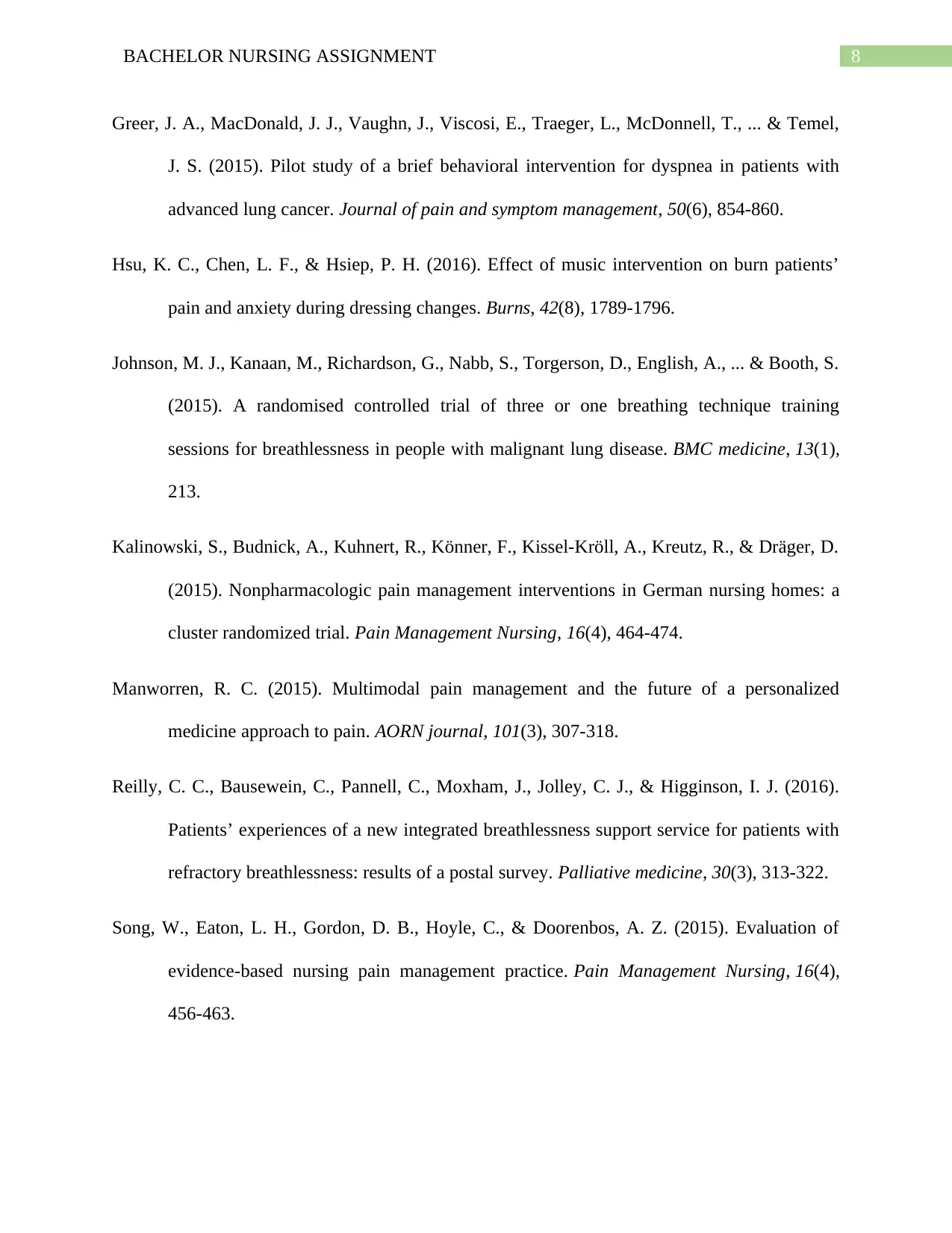
8BACHELOR NURSING ASSIGNMENT
Greer, J. A., MacDonald, J. J., Vaughn, J., Viscosi, E., Traeger, L., McDonnell, T., ... & Temel,
J. S. (2015). Pilot study of a brief behavioral intervention for dyspnea in patients with
advanced lung cancer. Journal of pain and symptom management, 50(6), 854-860.
Hsu, K. C., Chen, L. F., & Hsiep, P. H. (2016). Effect of music intervention on burn patients’
pain and anxiety during dressing changes. Burns, 42(8), 1789-1796.
Johnson, M. J., Kanaan, M., Richardson, G., Nabb, S., Torgerson, D., English, A., ... & Booth, S.
(2015). A randomised controlled trial of three or one breathing technique training
sessions for breathlessness in people with malignant lung disease. BMC medicine, 13(1),
213.
Kalinowski, S., Budnick, A., Kuhnert, R., Könner, F., Kissel-Kröll, A., Kreutz, R., & Dräger, D.
(2015). Nonpharmacologic pain management interventions in German nursing homes: a
cluster randomized trial. Pain Management Nursing, 16(4), 464-474.
Manworren, R. C. (2015). Multimodal pain management and the future of a personalized
medicine approach to pain. AORN journal, 101(3), 307-318.
Reilly, C. C., Bausewein, C., Pannell, C., Moxham, J., Jolley, C. J., & Higginson, I. J. (2016).
Patients’ experiences of a new integrated breathlessness support service for patients with
refractory breathlessness: results of a postal survey. Palliative medicine, 30(3), 313-322.
Song, W., Eaton, L. H., Gordon, D. B., Hoyle, C., & Doorenbos, A. Z. (2015). Evaluation of
evidence-based nursing pain management practice. Pain Management Nursing, 16(4),
456-463.
Greer, J. A., MacDonald, J. J., Vaughn, J., Viscosi, E., Traeger, L., McDonnell, T., ... & Temel,
J. S. (2015). Pilot study of a brief behavioral intervention for dyspnea in patients with
advanced lung cancer. Journal of pain and symptom management, 50(6), 854-860.
Hsu, K. C., Chen, L. F., & Hsiep, P. H. (2016). Effect of music intervention on burn patients’
pain and anxiety during dressing changes. Burns, 42(8), 1789-1796.
Johnson, M. J., Kanaan, M., Richardson, G., Nabb, S., Torgerson, D., English, A., ... & Booth, S.
(2015). A randomised controlled trial of three or one breathing technique training
sessions for breathlessness in people with malignant lung disease. BMC medicine, 13(1),
213.
Kalinowski, S., Budnick, A., Kuhnert, R., Könner, F., Kissel-Kröll, A., Kreutz, R., & Dräger, D.
(2015). Nonpharmacologic pain management interventions in German nursing homes: a
cluster randomized trial. Pain Management Nursing, 16(4), 464-474.
Manworren, R. C. (2015). Multimodal pain management and the future of a personalized
medicine approach to pain. AORN journal, 101(3), 307-318.
Reilly, C. C., Bausewein, C., Pannell, C., Moxham, J., Jolley, C. J., & Higginson, I. J. (2016).
Patients’ experiences of a new integrated breathlessness support service for patients with
refractory breathlessness: results of a postal survey. Palliative medicine, 30(3), 313-322.
Song, W., Eaton, L. H., Gordon, D. B., Hoyle, C., & Doorenbos, A. Z. (2015). Evaluation of
evidence-based nursing pain management practice. Pain Management Nursing, 16(4),
456-463.
⊘ This is a preview!⊘
Do you want full access?
Subscribe today to unlock all pages.

Trusted by 1+ million students worldwide
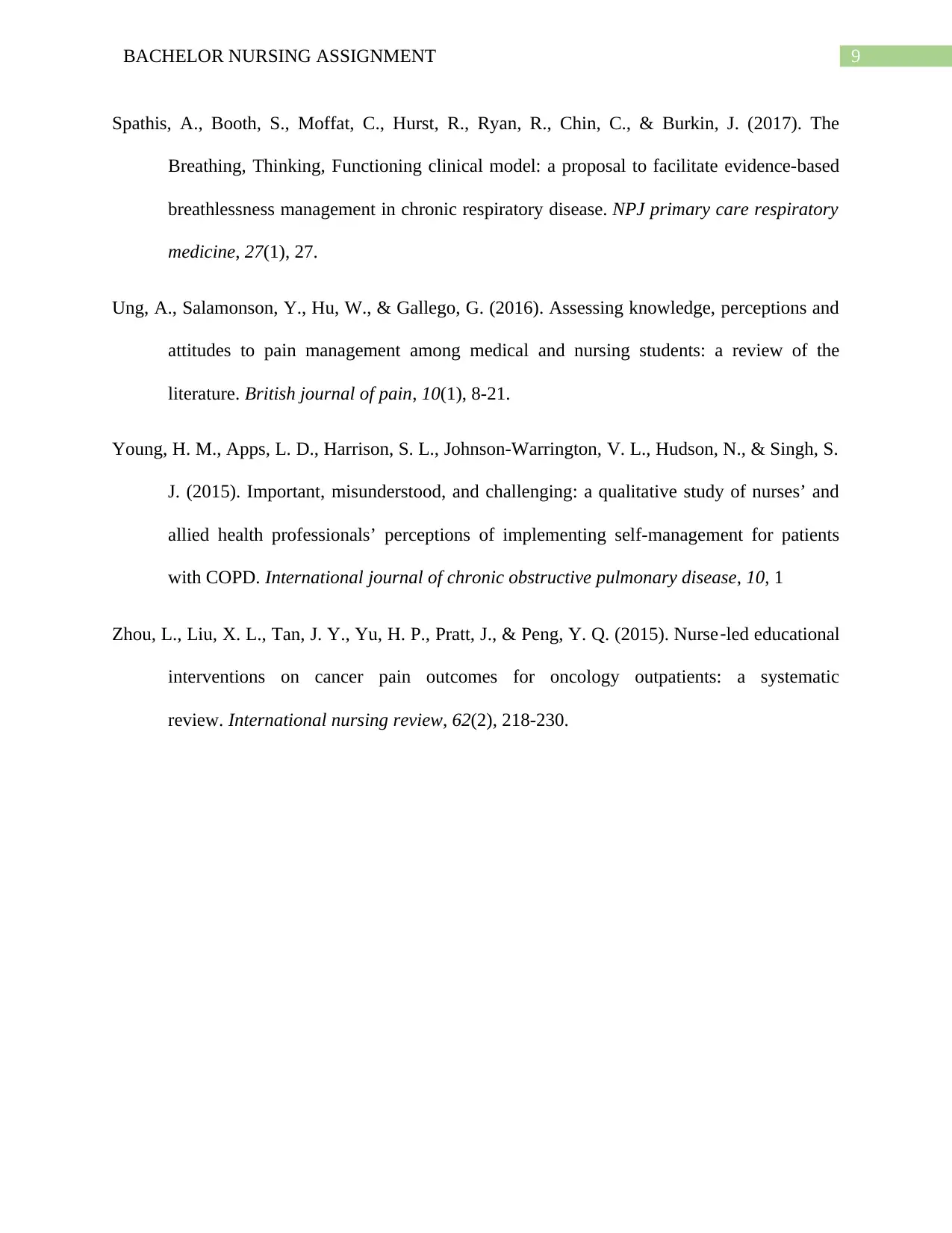
9BACHELOR NURSING ASSIGNMENT
Spathis, A., Booth, S., Moffat, C., Hurst, R., Ryan, R., Chin, C., & Burkin, J. (2017). The
Breathing, Thinking, Functioning clinical model: a proposal to facilitate evidence-based
breathlessness management in chronic respiratory disease. NPJ primary care respiratory
medicine, 27(1), 27.
Ung, A., Salamonson, Y., Hu, W., & Gallego, G. (2016). Assessing knowledge, perceptions and
attitudes to pain management among medical and nursing students: a review of the
literature. British journal of pain, 10(1), 8-21.
Young, H. M., Apps, L. D., Harrison, S. L., Johnson-Warrington, V. L., Hudson, N., & Singh, S.
J. (2015). Important, misunderstood, and challenging: a qualitative study of nurses’ and
allied health professionals’ perceptions of implementing self-management for patients
with COPD. International journal of chronic obstructive pulmonary disease, 10, 1
Zhou, L., Liu, X. L., Tan, J. Y., Yu, H. P., Pratt, J., & Peng, Y. Q. (2015). Nurse‐led educational
interventions on cancer pain outcomes for oncology outpatients: a systematic
review. International nursing review, 62(2), 218-230.
Spathis, A., Booth, S., Moffat, C., Hurst, R., Ryan, R., Chin, C., & Burkin, J. (2017). The
Breathing, Thinking, Functioning clinical model: a proposal to facilitate evidence-based
breathlessness management in chronic respiratory disease. NPJ primary care respiratory
medicine, 27(1), 27.
Ung, A., Salamonson, Y., Hu, W., & Gallego, G. (2016). Assessing knowledge, perceptions and
attitudes to pain management among medical and nursing students: a review of the
literature. British journal of pain, 10(1), 8-21.
Young, H. M., Apps, L. D., Harrison, S. L., Johnson-Warrington, V. L., Hudson, N., & Singh, S.
J. (2015). Important, misunderstood, and challenging: a qualitative study of nurses’ and
allied health professionals’ perceptions of implementing self-management for patients
with COPD. International journal of chronic obstructive pulmonary disease, 10, 1
Zhou, L., Liu, X. L., Tan, J. Y., Yu, H. P., Pratt, J., & Peng, Y. Q. (2015). Nurse‐led educational
interventions on cancer pain outcomes for oncology outpatients: a systematic
review. International nursing review, 62(2), 218-230.
1 out of 10
Related Documents
Your All-in-One AI-Powered Toolkit for Academic Success.
+13062052269
info@desklib.com
Available 24*7 on WhatsApp / Email
![[object Object]](/_next/static/media/star-bottom.7253800d.svg)
Unlock your academic potential
Copyright © 2020–2025 A2Z Services. All Rights Reserved. Developed and managed by ZUCOL.





